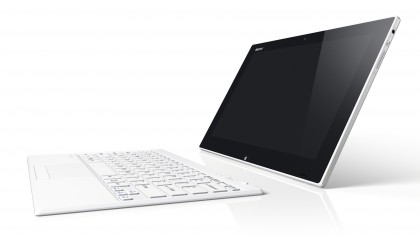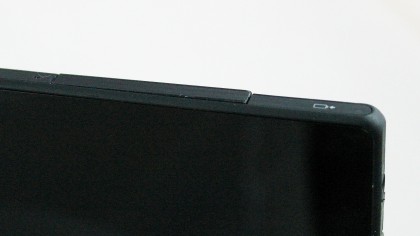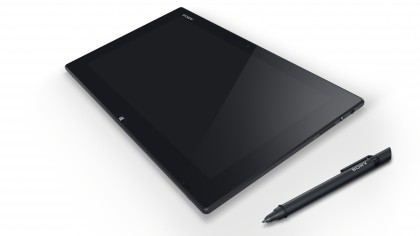TechRadar Verdict
Intel is still working on getting the right formula for its lower-powered chips, and that's very much clear in the Sony VAIO Tap 11. The dream of having a full Windows 8 PC in a truly iPad-like package is so close to being achieved here, but remains imperfect.
Pros
- +
Extremely thin
- +
Responsive keyboard cover
- +
Great Photoshop functionality
Cons
- -
Battery life could be better
Why you can trust TechRadar
Every month, it feels like the gap between tablets and laptops is getting smaller – or at least, it feels like a new company is trying to make it smaller.
Everything from the new Surface Pro 2 to the Samsung ATIV Smart PC or the Lenovo IdeaPad Miix 10 is trying to combine low-powered laptop components with a tablet's portability and weight.
The Sony VAIO Tap 11 comes in at the higher end of the spectrum for these kinds of machines, with a price tag of around £999/USD $1,606/AUD $1,692 for the model we used.
That's a huge amount steeper than the Lenovo Miix 10, but the Lenovo uses a meagre Intel Atom processor, while the VAIO Tap 11 has something new from Intel to show off.
There's a new kind of super-low-power processor at the heart of the Tap 11, called the Intel Core i5-4210Y.

We'll go into more details about it in the specifications section, but it basically uses the powerful Haswell architecture of Intel's latest chips, rather than the drastically simplified cores of the Atom chips. In theory, it's Haswell, in a tablet, with a low power draw!
The idea is that you can still have the slim and light tablet chassis, but without the frequently tedious performance of the Lenovo Miix 10 or the Acer Iconia W510. It's designed to go up against the Microsoft Surface Pro 2, rather than the low-end tablets.
Sign up to the TechRadar Pro newsletter to get all the top news, opinion, features and guidance your business needs to succeed!
And, indeed, the VAIO Tap 11 is nicely thin and light. It's 9.9mm thick, and weighs 780g, making only slightly heavier and thicker than the iPad 4, despite its extra processing power.
Decent specs
Sony has still managed to squeeze in a decent spec list in addition to the Intel Core i5 processor, though. There's 4GB of RAM, a 128GB SSD, a USB 3.0 port, Wi-Fi and Bluetooth 4.0, a micro-HDMI port and microSD card reader, NFC and front and rear cameras.
It also comes with a keyboard, much like many of its kind (though you still have to buy the Surface Pro's keyboard separately…), which doubles as a screen protector for when you travel. It's a very thin add-on, though it weighs almost as much as the tablet itself. It's wireless, and charges itself from the VAIO Tap 11 when it's connected to the front of the tablet magnetically. There's no other way to charge it, so if it gives up while you're working, you'll just have to… stop working.
There's also a powered stylus, which works with a digitizer in the screen to give you precision touch control and drawing. Both the keyboard and the stylus don't need setting up at all – just turn them on and they'll work, which is handy.
Sony is keen to point out the creative potential of the tablet, giving it a glorious 1920x1080 screen for detailed drawing. The screen is only 11.6 inches, so it's lovely and sharp.

From the front, the VAIO Tap 11 is a looker, with a glossy black front, and a smart bezel surrounding the screen. As with most Windows tablets, the idea of using it portrait mode has been pretty much abandoned, with a rear kickstand combining with the Sony logo and positioning of the Windows Start button on the front to indicate that you should just use it in landscape.
The Start button is quite annoying, because it's a quite resistive physical button rather than a touch-sensitive one, and if the tablet is standing using its kickstand you'll need to use two hands to stop it slipping around when pressing it.
It's a shame that the smart front is slightly marred by the connection for the keyboard to charge in the bottom corner, but it's not the only less desirably build element of the Tap 11.

The edges of the unit fit together well enough, but wherever there's an opening or flap they're incredibly poorly finished, with port covers not seating properly and rough, pointy corners around holes for the headphone jack or power cable.
The back is mostly just plain plastic, but you'll find speakers here, as well as a flip-out stand. The stand helps you create a laptop-like setup with the keyboard, and has a brilliant stiffness to it, so that you can adjust the angle of the screen.
They keyboard and pen are both really well-made, though, in simple matt black, so that they match the device overall.

The most unusual thing about the Sony VAIO Tap 11 is the new kind of Intel processor that it showcases. It's designed to allow the Tap 11 to provide capabilities closer to the Microsoft Surface Pro 2, but in a package more like the thinner regular Surface 2.
The chip used here is the Intel Core i5-4210Y. It's a dual-core chip, based on Intel's most up-to-date designs known as Haswell. As we said, other low-power Windows 8 machines, such as the Lenovo Miix 10, use Intel Atom processors, which are built differently, and optimised for lower energy consumption, with processing power suffering considerably as a result.
The Core i5-4210Y is an attempt to get better performing chips down to levels of power that will allow for something closer to the battery life of the iPad 4 without losing the fuller capabilities of Windows. Intel is suggesting that in some light-use scenarios, the chip could use just six Watts of power, which is around a third of the maximum power used by the higher performance Haswell ultraportable chips in the latest MacBook Air.
Max power
However, when you look at the maximum power used by the 4210Y, under heavy load, it's around 75% as power-hungry as the more powerful chips. We'll probably have to wait until Broadwell to see this kind of thing reach its potential, but if the technology is currently capable of giving the Tap 11 a nice long battery life for more basic use, it could be very useful here.
The dual-core 4210Y features Intel's HyperThreading technology, offering a boost in some operations, and is clocked at 1.5GHz, with Turbo Boost taking that up to 1.9GHz when possible.
It's no surprise to see that the graphics in the VAIO Tap 11 are of the integrated variety from Intel. The Intel HD 4200 is the lowest-end of Intel's graphics range for Haswell chips, which helps in keeping power use low, but means that it's a significant drop off in power compared to even the graphics in the MacBook Air.
However, Intel has continued to improve its graphics chip designs in Haswell, and the difference between what's in the VAIO Tap 11 and what's in Atom-powered tablets such as the Samsung ATIV Smart PC is vast.
Few surprises
Elsewhere, the VAIO Tap 11 carries few surprises, but that includes nothing nasty when it comes to specs.
The 4GB of RAM is plenty for most uses. It's not great for high-end graphics work, but should be fine for some photo editing, and is more than enough for home use or working on documents.
The 128GB SSD should keep sleep and wake times to a minimum, though the amount of free space really isn't huge – you'll have something like 50GB available to use for storage and programs. There is a microSD card slot for some additional storage space, at least.
As we said, there's 11.6-inch, 1920x1080 screen, which is the sort of thing we'd expect for a tablet at this price. The micro-HDMI port enables you to connect larger screens, too.
The standard USB 3.0 port is a nice addition, and it's good to see Bluetooth 4.0 included, allowing for low-power Bluetooth accessories to connect. The Wi-Fi is 802.11b/g/n, meaning that the fastest current protocol, 802.11ac, isn't included, but that's no surprise, and it's not really necessary for a tablet.
